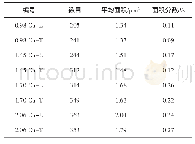《Table 3.The volume fractions of O, B2, α2 phases, size of O phase, and microhardness of the deforme
 提示:宽带有限、当前游客访问压缩模式
提示:宽带有限、当前游客访问压缩模式
本系列图表出处文件名:随高清版一同展现
《Morphology and quantitative analysis of O phase during heat treatment of hot-deformed Ti_2AlNb-based alloy》
The XRD patterns of the 950°C-solution-treated deformed alloys aged at different temperatures are illustrated in Fig.6.After the deformed specimen aged in the two-phase(B2+O)region,a mass of O phase appeared and the volume fraction of O phase was more than 64%(Table2).The volume fraction of the phases was calculated from the peak intensity of the patterns by Rietveld method[36].The volume fraction of the O phase in the deformed specimens is higher than that in the undeformed one.A graph of phase content of the 950°C-solution-treated undeformed and deformed alloys versus aging temperature is shown in Fig.7.After deformation,crystal defects formed during deformation,such as dislocations and subgrain boundaries,would offer large heterogeneous nucleation sites for the acicular O phase[37–38],resulting in the nucleation and growth of the acicular O phase along the crystal defects.With the elevating aging temperature,the phase content of O phase decreases and that of B2 phase increases,which indicates a transformation from O phase to B2 phase.The volume fraction of O phase decreased from 76.21%to 63.49%and80.51%to 64.12%for the undeformed alloy and deformed alloy,respectively,when the aging temperature rises from650°C to 800°C.This indicates that hot deformation restrains the transition from O to B2 at a low temperature.In other words,hot deformation accelerates the transformation process from B2 to O phase.Meanwhile,the volume fraction of theα2 phase is less than 10%both in the undeformed and deformed alloys.The transformation of the B2→α2 or O→α2 by mechanical displacement resulted in a fluctuation of theα2 content when the alloys were heat-treated in the phase regions containing O orα2 phase[39].Hence,it is difficult identify the variation rule of theα2 phase with the increasing aging temperature[40].
| 图表编号 | XD002880800 严禁用于非法目的 |
|---|---|
| 绘制时间 | 2018.10.01 |
| 作者 | Hong-yu Zhang、Chong Li、Zong-qing Ma、Li-ming Yu、Hui-jun Li、Yong-chang Liu |
| 绘制单位 | State Key Lab of Hydraulic Engineering Simulation and Safety, School of Materials Science & Engineering, Tianjin University、State Key Lab of Hydraulic Engineering Simulation and Safety, School of Materials Science & Engineering, Tianjin University、State K |
| 更多格式 | 高清、无水印(增值服务) |
查看“Table 3.The volume fractions of O, B2, α2 phases, size of O phase, and microhardness of the deformed alloys under 950°C”的人还看了
-

- Table 2 Volume fractions ofαphase in both{100}-and{111}-orientated grains within various zones by EBSD





